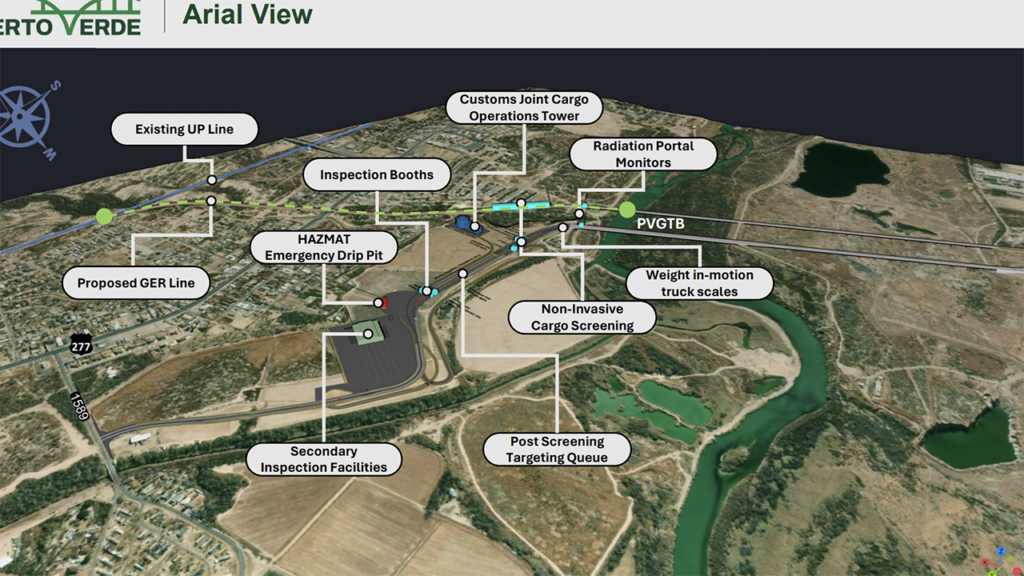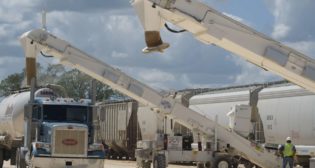
STB to Prepare EIS for Proposed Eagle Pass Rail Line
Written by Marybeth Luczak, Executive Editor
A map of Green Eagle Railroad LLC’s proposed 1.335-mile common carrier rail line in Maverick County, Tex., extending from the southern border of the United States and connecting to Union Pacific (UP) at approximately milepost 31 on the Eagle Pass Subdivision. The line is part of parent company PVH’s proposed trade corridor for freight and commercial motor vehicles extending into Mexico. (GER Map)
The Surface Transportation Board’s (STB) Office of Environmental Analysis on March 29 issued a Notice of Intent to prepare an Environmental Impact Statement (EIS) in connection with Green Eagle Railroad, LLC’s (GER) proposed construction and operation of an approximately 1.335-mile rail line in Maverick County, Tex., extending from the southern border of the United States and connecting to Union Pacific (UP) at approximately milepost 31 on the Eagle Pass Subdivision.
GER, a non-carrier subsidiary of Texas-based Puerto Verde Holdings (PVH), is developing the proposed line as an element of PVH’s proposed Puerto Verde Global Trade Bridge, which would “create a new trade corridor for freight rail and Commercial Motor Vehicles (‘CMV’) extending from the City of Eagle Pass to the U.S./Mexico border and then approximately 17.79 miles into the Mexican State of Coahuila,” GER reported in a Dec. 15, 2023, filing seeking STB approval of line construction.
GER told the STB that the purpose of building and operating the proposed 1.335-mile line is “to develop an economically viable solution to meet the needs for border infrastructure improvements that will increase safety and facilitate crucial binational trade between the United States and Mexico.”
GER said the existing border crossing in the City of Eagle Pass is the second busiest rail crossing between the U.S. and Mexico. It noted that currently rail traffic crosses the U.S./Mexican border at Eagle Pass via a single-tracked bridge belonging to UP on the U.S. side and owned by the Mexican federal government with rail operations concessioned to Ferrocarril Mexicano, S.A. de C.V. (Ferromex) on the Mexican side of the border; BNSF also operates on the line via trackage rights. Additionally, GER said, the current Eagle Pass Port of Entry rail bridge “is situated within the congested areas of the City of Eagle Pass, and Piedras Negras, Coahuila” and traverses nine at-grade rail crossings in the City of Eagle Pass and 16 at-grade crossings in Piedras Negras.

GER told the STB that it intends to construct and operate in Maverick County, Tex., a “double-tracked corridor with no at-grade crossings extending from the interchange point with UPRR [Union Pacific/UP] at approximately UPRR milepost 31 on the Eagle Pass Subdivision near the UPRR Clark’s Park yard extending 1.335 miles southwest and ‘terminating’ at the U.S./Mexican border on a newly constructed bridge that crosses the Rio Grande River. Further, GER would build infrastructure along the Proposed Line for U.S. and Mexican customs operations to include a customs control tower located between the Proposed Line and the CMV, providing for combined multi-modal cargo inspection.”
Because the proposed rail line has the potential to result in significant environmental impacts, STB’s Office of Environmental Analysis has determined that the preparation of an EIS is appropriate pursuant to the National Environmental Policy Act, the STB reported March 29. Issuance of the Notice of Intent (download below) begins the scoping period, the first step of the environmental review process.
The Office of Environmental Analysis will be accepting comments on the scope of the EIS, including alternatives and issues to be analyzed in the EIS, until April 29, 2024. It will hold three public scoping meetings: two in-person on April 16, 2024, and one virtual on April 23, 2024.
After the close of the scoping comment period, the Office of Environmental Analysis will review and address all comments as part of the environmental review process.


![“This record growth [in fiscal year 2024’s third quarter] is a direct result of our innovative logistic solutions during supply chain disruptions as shippers focus on diversifying their trade lanes,” Port NOLA President and CEO and New Orleans Public Belt (NOPB) CEO Brandy D. Christian said during a May 2 announcement (Port NOLA Photograph)](https://www.railwayage.com/wp-content/uploads/2024/05/portnola-315x168.png)
